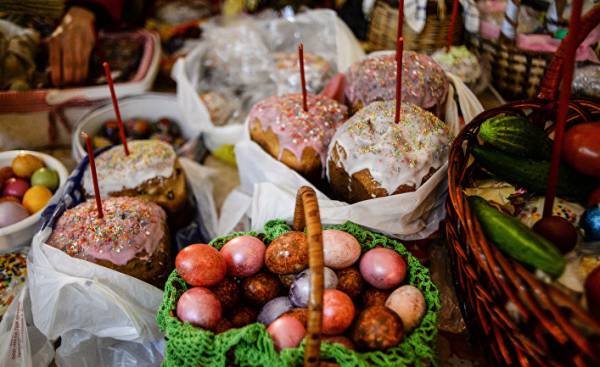
I love Easter traditions? Try this Ukrainian sweet cake, similar to panettone and a few other Easter dishes below served in different parts of Europe.
It is sometimes called cake, but we southerners like to say Easter. It’s slightly deranged cousin of the Italian panettone which I cook in the washed cans of tomatoes. Do not be alarmed that a base of mashed potatoes it is necessary to insist 12 hours, but the texture will be wonderful. We do a lot of cakes for Easter, our biggest religious holiday.
Ukrainian Easter bread
Designed for 3 cake 800 g
For the basics
3 potatoes, peeled and cut into pieces
1 liter of cold water
3 tbsp flour
For the test
250 ml warm milk
15 g fresh yeast or 7 g dry active yeast
4 egg yolks, at room temperature
150 g fine sugar
1 kg wheat flour
Sunflower oil
100 g raisins
For the glaze
175 g icing sugar
2 teaspoon vanilla extract
2 tbsp water
Colored sugar peas (optional)
1. To make the Foundation, fold the potatoes in a saucepan, cover with water and bring to a boil. Cook for 15 minutes until it is soft enough.
2. Drain the liquid, leaving the pot of 200 ml, and mash her potatoes.
3. Add the flour and mix thoroughly. Cover and leave in a warm place for 12 hours.
4. To make the dough, add the milk (make sure it is warm but not hot) and yeast to the base and mix well.
5. Whisk egg yolks with sugar in large mixer bowl until frothy.
6. Connect mix with milk and yeast and egg mixture. Gradually add and mix the flour — the dough should be thick, but not elastic. Cover the dough with a clean kitchen towel and leave to rise in a warm place for about an hour.
7. Brush your hands with a small amount of sunflower oil and knead the dough for about 15 minutes. Sprinkle the dough with raisins and vmese it.
8. Now divide the dough into four parts. Grease a clean 800-gram tin cans of tomatoes with sunflower oil and half fill them with dough. Let stand in a warm place for one hour. At this time, put the oven on to warm to 180C/350F or mark 4 gas stoves.
9. Place the jar on a baking sheet and bake for 40-45 minutes at the bottom of the oven. Let the cakes cool completely in the banks, then circle around the edge cooking with a spatula to get them.
10. To make the glaze, whisk sugar, flour, vanilla extract and water in a bowl and apply the mixture to the top of Easter cakes, letting glaze run down the sides. If you want colored sugar peas.
This is an excerpt from the first book Oli Hercules Mamushka: Recipes from Ukraine and Beyond. Her second book, Kaukasis the Cookbook will be published in August (also the publisher Mitchell Beazley); octopusbooks.co.uk.
Europudding: other Easter dishes that we have tried
Finnish mammi (which in Swedish is called “MEMA”) is a pudding made from rye flour and malt, which is traditionally baked and served in baskets made of birch bark. It is seasoned with orange zest and serve with whipped cream or vanilla ice cream. In the inimitable cookbook by Magnus Nilsson (Magnus Nilsson) Nordic Cookbook has her recipe, like the recipe for the Finnish version of the Easter Sunday dessert, which was adopted in the Russian Orthodox Church, curd Easter: ancient unusual delicacies from a mixture of dried fruit, honey, nuts and cheese, formed into a mound and decorated with two Cyrillic letters “X” and “b”, which means “Christ is Risen”.
Cupcakes
Throughout Eastern Europe, from Georgia to Bulgaria, Easter cottage cheese served with sliced chunks or cakes this Easter, which is common in the South of Ukraine — the recipe of which is in the first book Ollie Hercules Mamushka where she makes these lush cupcakes in the tin cans of tomatoes, watering them with a white glaze and is decorated with colored sugar peas. Greek them is braided pastry, decorated with almond flakes: a great recipe can be found in the book Rebecca Forces (Rebecca Seal) The Islands of Greece. We also have sweet Italian bread pane di Pascua (decorated with a colored egg in the middle), Portuguese folar de pascoa (flavored with caramel, anise, and cinnamon), pinca Croatian (similar to our hot Easter buns with a cross) and the German Osterbrot. Louise Weiss (Luisa Weiss) in a cookbook Classic German Baking for Easter morning making cakes in the form of rabbits with currant eyes. And she bakes unusual pochocki — Easter — bread originally from Aachen, which baked whole sugar cubes. Maybe someone will send us one?
Cakes
Given the beauty of spring rolls called semla — filled with a sweet whipped cream with cardamom — we would very much like to try these Scandinavian treats are served after Easter; many Swedes prefer chocolate Easter cake, and Hanemann Trine (Trine Hahnemann) are inclined to apricot-citrus classic Danish Easter cupcake decorated with delicate marzipan leaves. Finally, sounding like an ode to spring, which opens the door to Easter, “Alsatian lamb” — baked in consisting of two halves in the form of a lamb and sprinkled with powdered sugar. We gladly hoisted this elegant animal in the center of our Easter table.







